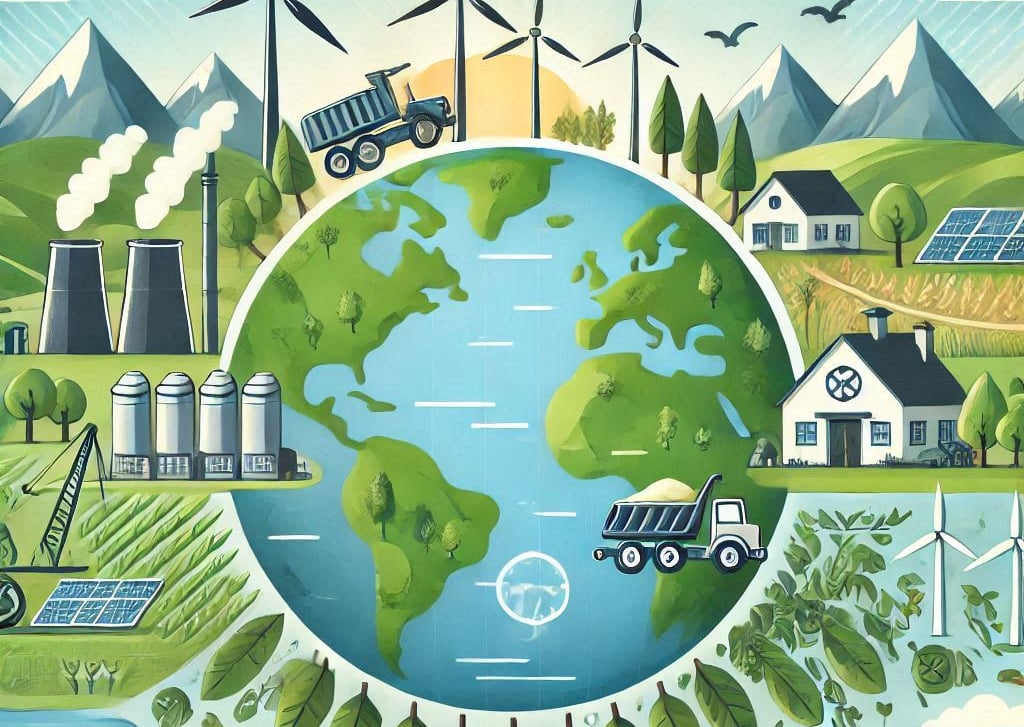Add your promotional text...
Natural Resources and Sustainable Development
MODULE -2
11/22/2024


Ø Overview of Natural Resources:
· Definition of Resource:
A natural resource is any material or substance that occurs in nature and can be used for economic gain. Examples include minerals, forests, water, and fertile land.
· Classification of Natural Resources:
Biotic and Abiotic:
Biotic Resources: These are derived from living organisms. Examples include forests, animals, and microorganisms. They are renewable as they can reproduce and regenerate.
Abiotic Resources: These come from non-living components of the environment. Examples include minerals, water, air, and land. They are often non-renewable as they do not regenerate on a human timescale.
Renewable and Non-Renewable:
Renewable Resources: These resources can be replenished naturally over short periods. Examples include solar energy, wind energy, and biomass. They are sustainable if managed properly.
Non-Renewable Resources: These resources are finite and cannot be replenished on a human timescale. Examples include fossil fuels (coal, oil, natural gas) and minerals (gold, silver, iron). Once depleted, they are gone forever.
Ø Biotic Resources:
Forests:
Description: Forests are large areas dominated by trees and other vegetation. They provide habitat for a wide range of species and play a crucial role in the global carbon cycle.
Status and Challenges: Deforestation for agriculture, logging, and urban development is a major threat. Conservation efforts focus on sustainable management and reforestation.
Grasslands:
Description: Grasslands are ecosystems where grasses are the dominant vegetation. They support a variety of herbivores and predators.
Status and Challenges: Overgrazing, agricultural conversion, and climate change threaten grasslands. Sustainable grazing practices and protected areas are key to their conservation.
Wetlands:
Description: Wetlands are areas where water covers the soil or is present near the surface for part of the year. They include marshes, swamps, and bogs.
Status and Challenges: Wetlands are threatened by drainage for agriculture, pollution, and climate change. Protection and restoration efforts are essential to maintain their ecological functions.
Wildlife:
Description: Wildlife includes all non-domesticated animals living in natural habitats. It is crucial for maintaining ecological balance and biodiversity.
Status and Challenges: Habitat loss, poaching, and climate change are major threats. Conservation strategies include protected areas, anti-poaching laws, and habitat restoration.
Aquatic Resources (Freshwater and Marine):
Description: Aquatic resources encompass all living organisms in freshwater (rivers, lakes) and marine (oceans, seas) environments.
Status and Challenges: Overfishing, pollution, and habitat destruction are significant threats. Sustainable fishing practices, marine protected areas, and pollution control are vital for their conservation.
Microbes:
Description: Microbes include bacteria, fungi, and other microorganisms. They play essential roles in nutrient cycling, decomposition, and biotechnology applications.
Status and Challenges: While microbes are abundant, their ecosystems can be disrupted by pollution, antibiotic resistance, and habitat destruction. Research and conservation of microbial diversity are important for ecosystem health and biotechnological advancements.
Ø Water Resources
Types of Water Resources
Fresh Water:
Sources: Rivers, lakes, ponds, streams, and groundwater.
Characteristics: Low salt content, essential for drinking, agriculture, and sanitation.
Marine Resources:
Sources: Oceans, seas, and coastal areas.
Characteristics: High salt content, supports marine life, and is used for activities like fishing and transportation.
Availability and Use of Water Resources
Availability:
Only about 2.5% of the Earth’s water is fresh water, with the majority locked in glaciers and ice caps.
Groundwater is the most abundant source of accessible fresh water.
Use:
Agriculture: Consumes about 70% of global fresh water.
Industry: Uses around 19% for processes like cooling and manufacturing.
Domestic: Accounts for about 11%, including drinking, cooking, and sanitation.
Environmental Impact of Over-Exploitation
Issues:
Depletion of Aquifers: Excessive groundwater extraction can lead to depletion and land subsidence.
Pollution: Overuse and contamination of water bodies affect ecosystems and human health.
Challenges:
Sustainable Management: Balancing water use with conservation to prevent long-term damage.
Climate Change: Alters precipitation patterns, exacerbating water scarcity.
Water Scarcity and Stress
Water Scarcity:
Occurs when demand exceeds supply, often due to overuse, pollution, and climate change.
Affects billions of people globally, leading to health and economic issues.
Water Stress:
Defined as the difficulty in meeting water demands due to limited availability or poor infrastructure.
Can lead to conflicts and displacement of populations.
Conflicts Over Water
Causes:
Transboundary Rivers: Disputes arise when rivers cross national borders, such as the Nile and Ganges.
Resource Allocation: Competing needs for agriculture, industry, and domestic use can lead to tensions.
Examples:
Middle East: Conflicts over the Jordan River and Tigris-Euphrates basin.
Africa: Disputes over the Nile River between Egypt, Sudan, and Ethiopia.
Ø Soil and Mineral Resources
Important Minerals
Major Minerals: These include calcium, chloride, magnesium, phosphorus, potassium, and sodium. They are required in larger amounts for various bodily functions such as bone health, fluid balance, and muscle function.
Trace Minerals: These include iron, zinc, selenium, copper, manganese, and iodine. They are needed in smaller amounts but are crucial for processes like oxygen transport, immune function, and enzyme activity.
Mineral Exploitation
Definition: Mineral exploitation involves the extraction and processing of minerals from the earth, which includes activities like mining, drilling, and quarrying.
Methods:
Underground Mining: Extracting minerals from deep underground.
Surface Mining: Removing minerals from the surface, including open-pit mining.
Placer Mining: Extracting minerals from riverbeds or beach sands.
Environmental Problems Due to Extraction of Minerals
Erosion and Sinkholes: Mining activities can cause significant soil erosion and the formation of sinkholes.
Loss of Biodiversity: Habitat destruction due to mining leads to a decline in local flora and fauna.
Water Contamination: Chemicals used in mining can contaminate groundwater and surface water, affecting ecosystems and human health.
Air Pollution: Dust and emissions from mining operations contribute to air pollution and climate change.
Soil as a Resource and Its Degradation
Soil as a Resource:
Functions: Soil supports plant growth, stores water and nutrients, and acts as a habitat for organisms. It is essential for agriculture and forestry.
Soil Degradation:
Causes: Overgrazing, deforestation, improper agricultural practices, and industrial activities lead to soil degradation.
Types:
Erosion: Removal of the topsoil layer by wind or water.
Salinization: Accumulation of salts in soil, often due to improper irrigation.
Acidification: Lowering of soil pH due to acid rain or excessive use of fertilizers.
Effects: Reduced soil fertility, loss of arable land, and decreased agricultural productivity.
Ø Energy Resources
Sources of Energy and Their Classification
Renewable Sources: These are naturally replenished on a human timescale. Examples include solar, wind, hydro, geothermal, and biomass.
Non-Renewable Sources: These are finite and deplete over time. Examples include coal, oil, natural gas, and nuclear energy.
Conventional Energy Sources
Coal: A fossil fuel used primarily for electricity generation and industrial processes. It is abundant but contributes significantly to air pollution and greenhouse gas emissions.
Oil: Also known as petroleum, it is used for transportation fuels, heating, and electricity generation. It is extracted through drilling and has a high environmental impact due to spills and emissions.
Natural Gas: A cleaner fossil fuel compared to coal and oil, used for heating, electricity generation, and as an industrial feedstock. It is extracted through drilling and fracking.
Nuclear Energy: Produced from uranium through nuclear fission. It generates large amounts of electricity with low greenhouse gas emissions but poses challenges related to radioactive waste disposal and potential accidents.
Non-Conventional Energy Sources
Solar Energy: Harnessed from the sun using photovoltaic cells or solar thermal systems. It is abundant and clean but dependent on weather and daylight.
Wind Energy: Generated using wind turbines. It is renewable and clean but can be intermittent and requires large areas for wind farms.
Tidal Energy: Produced from the movement of tides. It is predictable and renewable but limited to coastal areas with significant tidal ranges.
Hydro Energy: Generated from the flow of water in rivers or dams. It is a reliable and established source of renewable energy but can impact local ecosystems.
Wave Energy: Derived from the surface motion of oceans. It is renewable but still in the experimental stage and can be challenging to harness.
Ocean Thermal Energy: Utilizes temperature differences between surface and deep ocean water to generate electricity. It is renewable but technologically complex.
Geothermal Energy: Extracted from the Earth’s internal heat. It is reliable and sustainable but location-specific.
Biomass: Organic material from plants and animals used as fuel. It is renewable but can compete with food production and lead to deforestation.
Hydrogen and Fuel Cells: Hydrogen can be used as a clean fuel in fuel cells to generate electricity. It is renewable if produced using renewable energy sources but currently expensive and requires infrastructure development.
Implications of Energy Use on the Environment
Air Pollution: Burning fossil fuels releases pollutants like Sulphur dioxide, nitrogen oxides, and particulate matter, contributing to smog and respiratory problems.
Greenhouse Gas Emissions: Fossil fuels emit carbon dioxide and methane, major contributors to global warming and climate change.
Water Pollution: Oil spills, runoff from mining, and thermal pollution from power plants can contaminate water bodies.
Land Degradation: Mining and drilling activities can lead to habitat destruction, soil erosion, and loss of biodiversity.
Waste Generation: Nuclear energy produces radioactive waste that requires long-term management.
Ø Introduction to Sustainable Development
Sustainable Development:
Definition: Sustainable development is the practice of meeting current needs without compromising the ability of future generations to meet their own needs. It integrates economic growth, social inclusion, and environmental protection.
Sustainable Development Goals (SDGs)
Overview:
Adoption: The SDGs were adopted by all United Nations Member States in 2015 as part of the 2030 Agenda for Sustainable Development.
Purpose: They aim to address global challenges, including poverty, inequality, climate change, environmental degradation, peace, and justice.
The 17 Goals:
No Poverty
Zero Hunger
Good Health and Well-Being
Quality Education
Gender Equality
Clean Water and Sanitation
Affordable and Clean Energy
Decent Work and Economic Growth
Industry, Innovation, and Infrastructure
Reduced Inequalities
Sustainable Cities and Communities
Responsible Consumption and Production
Climate Action
Life Below Water
Life on Land
Peace, Justice, and Strong Institutions
Partnerships for the Goals.
Targets and Indicators
Structure:
Each goal has specific targets (169 in total) and indicators (231 unique indicators) to measure progress.
Targets: Define the specific outcomes to be achieved.
Indicators: Provide metrics to assess progress towards each target.
Challenges
Key Challenges:
Inequality: Persistent disparities in income, education, and access to resources.
Resource Scarcity: Limited natural resources and the need for sustainable management.
Healthcare Disparities: Unequal access to healthcare services.
Political Hurdles: Governance issues and lack of political will in some regions.
Climate Change: Increasing impacts of climate change affecting all aspects of life.
Strategies for Achieving SDGs
Approaches:
Integrated Policies: Developing policies that address multiple goals simultaneously.
International Cooperation: Strengthening global partnerships and cooperation.
Innovative Solutions: Leveraging technology and innovation to solve complex problems.
Local Implementation: Tailoring strategies to local contexts and involving communities.
Monitoring and Accountability: Regularly tracking progress and holding stakeholders accountable.
Asst. Prof. S. B. Mache
Author & Co-founder of SkratchCodes.in


